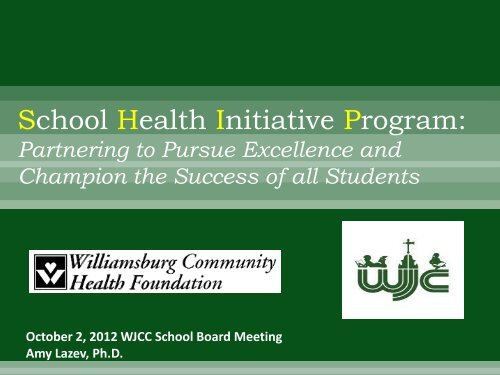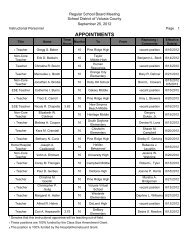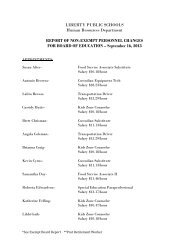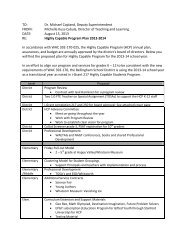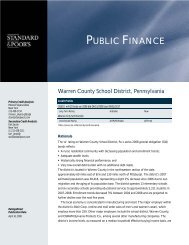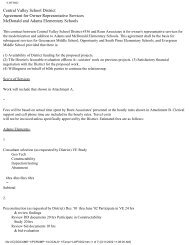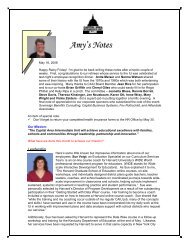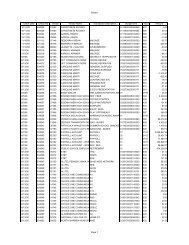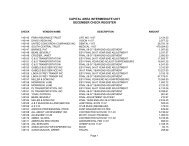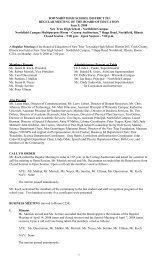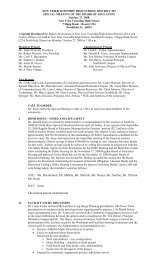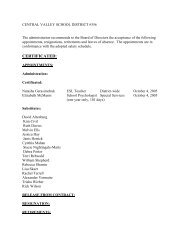School Health Initiative Program: - BoardDocs
School Health Initiative Program: - BoardDocs
School Health Initiative Program: - BoardDocs
Create successful ePaper yourself
Turn your PDF publications into a flip-book with our unique Google optimized e-Paper software.
<strong>School</strong> <strong>Health</strong> <strong>Initiative</strong> <strong>Program</strong>:<br />
Partnering to Pursue Excellence and<br />
Champion the Success of all Students<br />
October 2, 2012 WJCC <strong>School</strong> Board Meeting<br />
Amy Lazev, Ph.D.
Partnership with a Mission<br />
The mission of SHIP is to improve the health<br />
and wellness of WJCC students and staff by<br />
supporting and promoting healthy eating and<br />
active lifestyle habits in the schools, homes,<br />
and the community.
Obesity Trends* Among U.S. Adults<br />
BRFSS, 1990<br />
No Data
Obesity Trends* Among U.S. Adults<br />
BRFSS, 2000<br />
(*BMI ≥30, or ~ 30 lbs. overweight for 5’ 4” person)<br />
No Data
Obesity Trends* Among U.S. Adults<br />
BRFSS, 2005<br />
(*BMI ≥30, or ~ 30 lbs. overweight for 5’ 4” person)<br />
No Data
Obesity Trends* Among U.S. Adults<br />
BRFSS, 2010<br />
(*BMI ≥30, or ~ 30 lbs. overweight for 5’ 4” person)<br />
No Data
National Data<br />
• Obesity rate among children<br />
• 13% > 95 th %<br />
• 15.2% overweight >85 th % < 95 th %<br />
• Physical activity<br />
• 13.8% not getting exercise<br />
• Sedentary behaviors<br />
• 31.1% using computer/video > 3 hours per day<br />
• 32.4% watching 3 or more hours of TV per day<br />
YRBSS, 2011. National 9 th – 12 th grade student survey
National Data<br />
• <strong>Health</strong>y eating<br />
• 4.8% not eating fruit/ drinking fruit juice<br />
• 5.7% not eating vegetables<br />
• 13.1% not eating breakfast<br />
• Sleep<br />
• 68.6% not getting 8 or more hours of sleep
Division Strategic Plan<br />
• Priority One: High Student Achievement for<br />
21 st Century Success<br />
• Priority Two: Safe, Secure and Welcoming<br />
Climate for Learning
Percentage of High <strong>School</strong> Students Who Drank a Can, Bottle, or Glass of Soda or Pop at<br />
Least One Time Per Day,* by Type of Grades Earned (Mostly A’s, B’s, C’s or D’s/F’s), 2009**<br />
*Drank a can, bottle, or glass of soda or pop (not including diet soda or diet pop) at least one time per day during the 7 days before the survey.<br />
**p
Percentage of High <strong>School</strong> Students Who Were Physically Active<br />
at Least 60 Minutes Per Day on Less Than 5 Days,* by Type<br />
of Grades Earned (Mostly A’s, B’s, C’s or D’s/F’s), 2009**<br />
*Any kind of physical activity that increased their heart rate and made them breathe hard some of the time on less than 5 days<br />
during the 7 days before the survey.<br />
**p
WJCC 2010-2011 Student Data<br />
• Collected in partnership with the<br />
Williamsburg Community <strong>Health</strong> Foundation<br />
( WCHF) and The College of William & Mary<br />
• 82.6% response rate (N=4980)<br />
• Assessment included: eating, physical<br />
activity, sleep, school engagement<br />
• BMI (3 rd , 5 th , 7 th graders)
Daily Diet<br />
• Fruit – 90.2%<br />
• Green salad – 66.5%<br />
• Vegetables – 89.9%<br />
• Ate breakfast – 61.2% (5 or more days per<br />
week)<br />
• Soda – 40.8%<br />
• Sports/ sweetened drinks – 52%
Physical Activity, Sedentary<br />
Behaviors & Sleep<br />
• Active for > 60 min per day for 5 or more days =<br />
57.3%<br />
• 3 or more hours of TV per day = 22.8%<br />
• 3 or more hours video/ computer (non-school<br />
related) = 25.9%<br />
• Insufficient sleep (7 or less hours) = 53.9%
Body Mass Index (BMI) - 2011<br />
3%<br />
64%<br />
15%<br />
3 rd , 5 th & 7 th graders (N= 2038)<br />
18%<br />
Underweight<br />
<strong>Health</strong>y weight<br />
At risk<br />
Overweight
How do we create change and<br />
make a cultural shift?<br />
• Educate students, families and staff on healthy<br />
eating, physical activity, and sufficient sleep<br />
• Teach skills<br />
• Provide the environment<br />
• Create the support systems (family and<br />
community) to sustain life-long healthy habits
100<br />
90<br />
80<br />
70<br />
60<br />
50<br />
40<br />
30<br />
20<br />
10<br />
Daily Eating Improvements<br />
0<br />
Fruit Fruit Juice Green Salad<br />
The College of William & Mary Student Survey, 2011<br />
2006<br />
2008<br />
2010
Physical Activity & Sedentary<br />
Behavior Improvements<br />
70<br />
60<br />
50<br />
40<br />
30<br />
20<br />
10<br />
0<br />
Active 5 or more days 3 or more hours of t.v.<br />
per day<br />
The College of William & Mary Student Survey, 2011<br />
2006<br />
2008<br />
2010
Areas of Future Focus<br />
100<br />
90<br />
80<br />
70<br />
60<br />
50<br />
40<br />
30<br />
20<br />
10<br />
0<br />
Daily<br />
vegetable<br />
Breakfast Daily soda Daily sports<br />
drink<br />
2006<br />
2008<br />
2010
SHIP’s Strategic Plan for lifelong<br />
healthy habits<br />
1) Community: Outreach<br />
2) Family: PTA<br />
3) <strong>School</strong>: Wellness Council Leaders and CNS<br />
partnership<br />
4) Teachers: Wellness Integration<br />
5) Students: Challenge Clubs
Community<br />
Family<br />
<strong>School</strong><br />
Teachers<br />
Student
Evaluation<br />
• Partner with WCHF and W&M to refine<br />
evaluation<br />
• Link program components with outcomes<br />
• Data-driven decision making
Thank you


